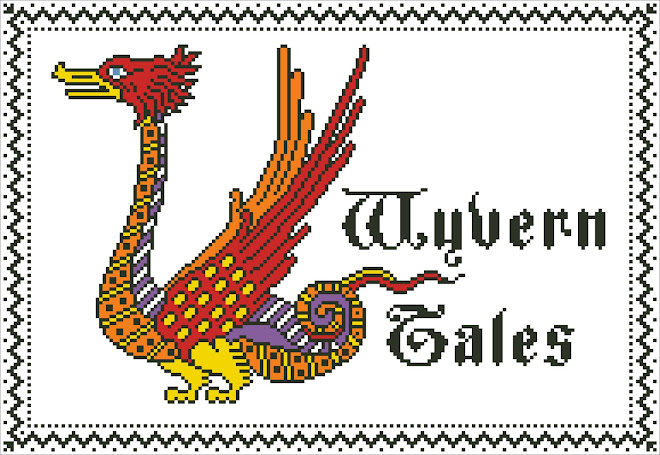Step 1 is the fun step which involves looking through many books for possible pattern sources. These can be books on medieval manuscripts or archaeological excavations or even generic history books along the line of "the Anglo-Saxons in England". Here, for example, is a detail from a print by Albrecht Duerer, done ca. 1496-97, titled "The Seven Trumpets" (The Apocalypse).
Step 2 involves making a line drawing of the basic lines of the design. I first enlarge the detail as much as possible, then trace it onto white paper on a light table.
Step 3 is where the line drawing is transformed into a rough graph. I take the line drawing and scan it into the computer. Then, using PatternMaker by HobbyWare (a very good software program for stitchers), I import the line drawing. This is not as easy as it sounds! Many attempts are usually needed, using different size parameters, to get the design where the smaller details can be done clearly. Fingers, toes, faces, and wings are the hardest to get correct.
Step 4 is where most of the hard work takes place. Although it is difficult to see above, the rough chart is made up of many close shades of greys. Lines are not yet clearly defined. It takes literally hours and hours to refine the rough chart and then to add all the details that bring it as close to the original as possible, or at least to give the feeling of the original. With a complicated design such as this, it is impossible to get Duerer's fineness of line, but I try to approximate it.
Step 5 is another fun step. I get out my skeins of the entire DMC line of floss and "color inside the lines". Medieval illuminations were done in exactly the same way -- outline first, color second -- so I feel I'm following at least the correct sequence. It is always intriguing to me how changing the shade of a color, even by one very small degree, can made such a dramatic difference in the overall effect of the piece. In this case, primary colors worked best, although stitchers are always encouraged to make their own color choices if they'd prefer. Also, in this particular design, I would encourage the use of silver and gold filament threads with the whites of the wings and the yellow of the trumpet to give it a slight sparkle.
Step 6 is the icing on the cake, adding the border. Not every design needs one, but it is amazing what a perfect border can do to the overall design. This, in itself, can be very time-consuming as not only does the border have to have the right proportions compared with the main element(s) of the design, but it has to be centered around the design in a way that balances the whole impression. And voila! Duerer's trumpeting angel is now ready for stitching.








Very interesting article, I have done some digitizing for my embroidery machine so I know all the work that goes into a design. I love the angel, I have collected angels for years. Currently I am working on your Welcome Angel.
ReplyDeleteBonnie